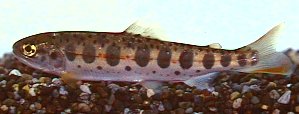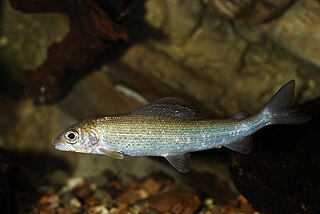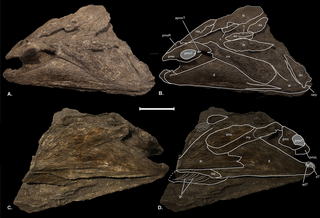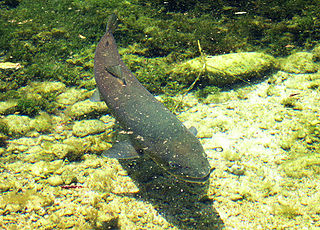
Salmon is the common name for several commercially important species of euryhaline ray-finned fish from the genera Salmo and Oncorhynchus of the family Salmonidae, native to tributaries of the North Atlantic (Salmo) and North Pacific (Oncorhynchus) basins. Other closely related fish in the same family include trout, char, grayling, whitefish, lenok and taimen, all coldwater fish of the subarctic and cooler temperate regions with some sporadic endorheic populations in Central Asia.

Salmonidae is a family of ray-finned fish that constitutes the only currently extant family in the order Salmoniformes, consisting of 11 extant genera and over 200 species collectively known as "salmonids" or "salmonoids". The family includes salmon, trout, char, graylings, freshwater whitefishes, taimens and lenoks, all coldwater mid-level predatory fish that inhabit the subarctic and cool temperate waters of the Northern Hemisphere. The Atlantic salmon, whose Latin name became that of its genus Salmo, is also the eponym of the family and order names.

The masu salmon, also known as masu or cherry trout in Japan, is a species of salmonid belonging to the genus Oncorhynchus, found in the North Pacific along Northeast/East Asian coasts from the Russian Far East to south through Korea, Japan and Taiwan. Although generally accepted as a salmon in the West, the fish is actually regarded as a trout in Japan as it is the most commonly seen freshwater salmonid in the Japanese archipelago.

Thymallus thymallus, the grayling or European grayling, is a species of freshwater fish in the salmon family Salmonidae. It is the only species of the genus Thymallus native to Europe, where it is widespread from the United Kingdom and France to the Ural Mountains in Russia, and Balkans on the south-east, but does not occur in the southern parts of the continent. It was introduced to Morocco in 1948, but it does not appear to have become established there.
Siberian taimen, also known as the common taimen, Siberian giant trout or Siberian salmon, is a species of salmon-like ray-finned fish from the genus Hucho in the family Salmonidae. These fish are found in rivers in Siberia and adjacent regions, and are harvested throughout the year.

The huchen, also known as Danube salmon or redfish, is a large species of freshwater fish in the family Salmonidae native to the Danube basin in Central and Eastern Europe. It is the type species of genus Hucho, being closely related to salmon, trout, char and lenoks.

Pink salmon or humpback salmon is a species of euryhaline ray-finned fish in the family Salmonidae. It is the type species of the genus Oncorhynchus, and is the smallest and most abundant of the seven officially recognized species of salmon. The species' scientific name is based on the Russian common name for this species gorbúša (горбуша), which literally means humpie.

Oncorhynchus is a genus of ray-finned fish in the subfamily Salmoninae of the family Salmonidae, native to coldwater tributaries of the North Pacific basin. The genus contains twelve extant species, namely six species of Pacific salmon and six species of Pacific trout, all of which are migratory mid-level predatory fish that display natal homing and semelparity.
The Sakhalin-2 project is an oil and gas development in Sakhalin Island, Russia. It includes development of the Piltun-Astokhskoye oil field and the Lunskoye natural gas field offshore Sakhalin Island in the Okhotsk Sea, and associated infrastructure onshore. The project is managed and operated by Sakhalin Energy Investment Company Ltd..

Hucho is a genus of large piscivorous salmonid fish known as taimens, and is closely related to Pacific trout and lenoks. Native to the cold rivers and other freshwater habitats in Eurasia, they are threatened by overfishing and habitat loss.

The Atlantic whitefish is a coregonine fish inhabiting some freshwater lakes within Nova Scotia, Canada. It is known to survive only in the Petite Rivière watershed as landlocked populations. Earlier it was also found in the Tusket and Annis rivers of Nova Scotia. Those populations were anadromous, migrating to the estuary to feed while breeding in freshwater.

Oncorhynchus rastrosus also known as the saber-toothed salmon, or spike-toothed salmon is an extinct species of salmon that lived along the Pacific coast of North America and Japan. They first appeared in the late Miocene in California, then died out some time during the Early Pliocene. They are members of the genus Oncorhynchus, which contains living pacific salmon.

The Krivaja is a river in central-northern parts of Bosnia and Herzegovina, and a right tributary of the Bosna River. Its source is confluence of the Stupčanica and the Bioštica rivers at the western outskirts of town of Olovo. From there the Krivaja flows through the scenic gorge between mountains of Zvijezda and Konjuh (mountain), with lot of small mountain streams and small rivers inflow from both sides. Finally, the Krivaja meets the Bosna River at the vicinity of town of Zavidovići.
The wildlife of Japan includes its flora, fauna, and natural habitats. The islands of Japan stretch a long distance from north to south and cover a wide range of climatic zones. This results in a high diversity of wildlife despite Japan's isolation from the mainland of Asia. In the north of the country, north of Blakiston's Line, there are many subarctic species which have colonized Japan from the north. In the south there are south-east Asian species, typical of tropical regions. Between these areas lies the temperate zone which shares many species with China and Korea. Japan also has many endemic species that are found nowhere else in the world, making it home to many endangered/rare species.

Hucho bleekeri, the Sichuan taimen, is a species of freshwater fish in the salmon family (Salmonidae), endemic to the Yangtze basin in China. Their typical habitat includes mountain streams and small rivers, typically being found in the catchment areas of the Dadu River in Sichuan and Qinghai Provinces, as well as the Hanjiang River and its tributaries in southern Shaanxi province. This particular fish population is largely threatened by habitat loss and illegal fishing, resulting in a "critically endangered" conservation status from the International Union for Conservation of Nature.

Hucho ishikawae, the Korean taimen, is a species of salmonid fish found in the border region between North Korea and China, including the Am-nok or Yalu, Dok-ro, Weon-ju and Jang-jin Rivers. Monitoring of the species has been made very difficult because of the lack of access to the areas in which this species occurs and consequently it is rated as data deficient by the IUCN. It is found in flowing water and reaches up to 50 cm (20 in) in length. Like others of the Hucho genus this fish is an active predator.
The Samarga is the northernmost river in the Primorsky Krai territory in the far eastern part of Russia. It is 218 kilometres (135 mi) long, and has a drainage basin of 7,760 square kilometres (3,000 sq mi), making it the largest coastal river in the northern Sikhote-Alin mountain range. It flows into the Sea of Japan. The river system is a unique and relatively untouched centre of biodiversity in the Eastern Sikhote–Alin mountains because it is in a remote and mountainous region.
The Kaljina is a river in the central-northeastern part of Bosnia and Herzegovina, municipality of Sokolac. The source of the river is on Ozren Sarajevski, in the area of "Vrela" near Ozren village, while the majority of its course runs across Nišići karst plateau, where the river passes through a village with a same name, Kaljina, which is the largest settlement on its course. After about 26 kilometers of scenic flow from source to confluence, through the pristine nature of the plateau, the Kaljina meets Bioštica near the town of Olovo. The Krivaja basin is known for an abundant fish fauna, rich in species, some of which are critically endangered, such as Danube Salmon (Hucho hucho). All the Krivaja tributaries and especially its headwaters are important spawning grounds for both Danube Taimen and its prey, Common nase and Grayling . The Kaljina, its parent the Bioštica, and the Stupčanica are the main source of the Krivaja waters, and all three are unspoiled in sense of water quality, their hydromorphology, natural surroundings and river biodiversity. The rich pool of indigenous salmonids such as Danube brown trout, spawning grounds for huchen and nase, can only be maintained through statutory protection, and preservation of the Krivaja basin streams and rivers uninterrupted flow from construction of dams. However plans for hydropower development exist, and represent a real risk for unspoiled natural environment of the region.
Salvelinus czerskii, also known as Cherskii's char, is a freshwater species of fish of the genus salvelinus found in the Indigirka and Chukochya river basins in arctic Russia.














